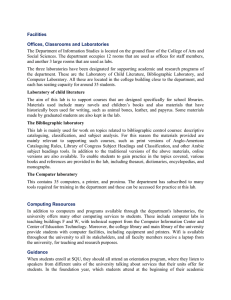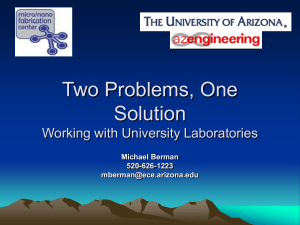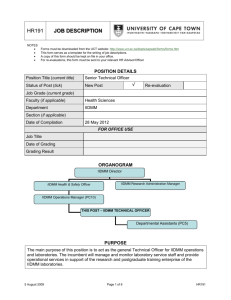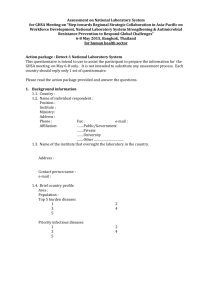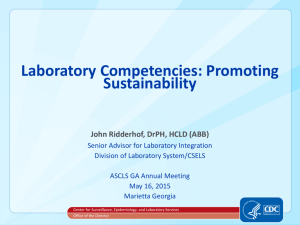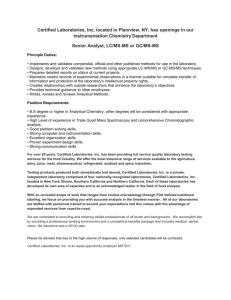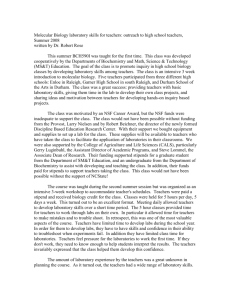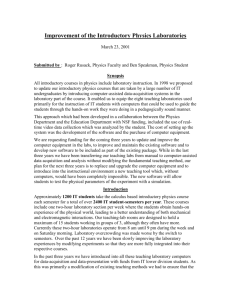Know Your State Public Health Laboratory
advertisement
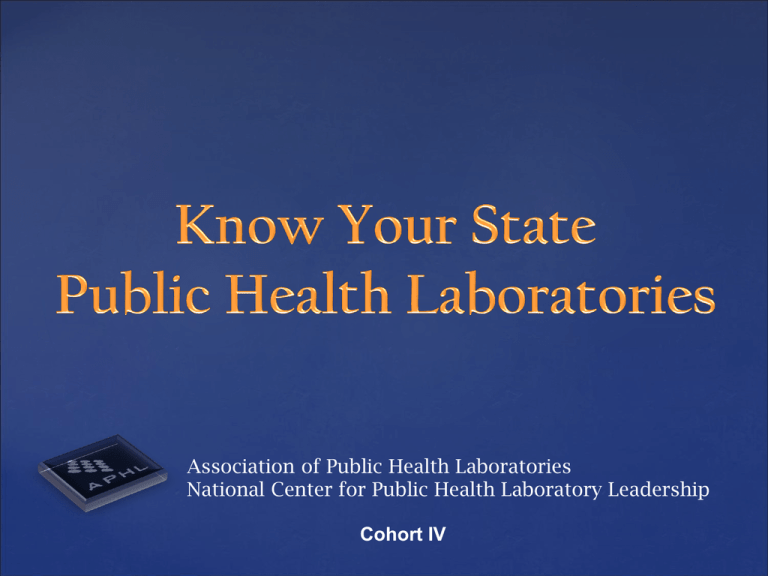
Association of Public Health Laboratories National Center for Public Health Laboratory Leadership Cohort IV Our Mission is to promote, protect and preserve the health and well-being of the people by promoting and enforcing standards of quality in cooperation with both public and private agencies at the federal, state, and local levels. CORE Functions of the Association of State Public Health Laboratories Disease prevention, control, and surveillance Integrated data management Reference and specialized testing Environmental health and protection Food safety Laboratory improvement and regulation Policy development Emergency response Public health-related research Training and education Partnerships and communication 52 state PHL are the interface between federal labs, and the local, hospital and private labs Federal CDC, FDA, USDA, EPA, others Hundreds of Local (county & city) PHL Thousands of hospitals, private labs Serve As the First Line of Defense in Protecting the Public from Diseases and Health Hazards Laboratory staff training Technical Consultation Clinical, consumer product, & Environmental testing Emergency preparedness & response Aid in special public health investigation Disease surveillance Research & new technology Work Toward Increasing Laboratory Capacity Routine specimen/sample monitoring Emergency Response Research and validation of new testing methods Biosafety training Result interpretation Regulatory requirements Trainings and workshops Leadership forums Technical conferences Networking and lab linkages Disciplined Approach To Laboratory Testing Continuous employee competency evaluation Annual ethics training Regulations conformance Continuous quality improvement Employee safety training Continuing education opportunities for employees 24/7 Assigned essential emergency employees Participating in emergency response proficiency test exercise Laboratory Routinely Screen babies born in the US for potentially life-threatening metabolic and genetic disorders Monitor communities for pathogens that spread in food or through contact with people or animals Detect and monitor newly emerging infectious diseases like West Nile virus, SARS and avian influenza Test drinking water for bacteria, parasites, pesticides, metals, and other harmful substances Test surface water for fertilizer run off and other contaminations Test consumer products, air, and radiation Test animals for rabies Clinical/ Private Labs Public Labs Diagnostic Testing Some Reference Testing Interdependent Network Reference Testing Medical management Focus = Individual health Some Diagnostic Testing Identify and Respond to Public Health Threats Surveillance and Monitoring Focus = Public health Expanding Ability to Emergency Response • Center for Disease Control & Prevention (CDC) • Environmental Protection Agency (EPA) • Laboratory Response Network (LRN) Infectious Disease Bacterial pathogens and Chemical Welfare agents Drinking Water and other Environmental Samples Foods and other Consumer Products • Food Emergency Response Network (FERN) Standardized diagnostics Secure communication, alert, reporting system Training and instrumentation standards Quality standards testing Assurance of biosafety and biosecurity RI Puerto Rico NAHLN (animal) eLRN FERN (environmental) (food) NPDN (plant) LRN (human) 2011: Groundbreaking for new central lab 2005: Procured funding for new LIMS system 2001: First terrorism event (anthrax) 2000: Lab Emergency Preparedness program established 1985: HIV Section established 1971: Environmental Chemistry Division established 1965: First hereditary disorder screened 1957: Virology Section established 1946: Cytology and clinical chemistry established 1942: Syphilis testing for military 1910: First separate State laboratory facility 1898: Established with $2,500 and 1 employee History of Your State Public Health Laboratory System Proactively Seek to be Prepared in the Changing World New Born & Childhood Screening ― Endocrinology/Hemoglobinopathy/Biochemical Virology & Immunology ― Microbial Serology/Vaccine Preventable Virus/Hepatitis Testing/ Virus Isolation & Chlamydia/Rabies Zoonotic & Emerging Disease Molecular Biology ― Retro-Virology/Viral Disease Assessment /Molecular Epidemiology/Molecular Diagnostics/Biowatch/BT Public Health Microbiology ― Enteric and Diarrheal Disease/Foodborne Diseases/ Gonococcal (GC)/Bioterrorism TB/Mycobacteriology Environmental Chemistry ― Air/Radiation/Organics/Inorganics/Trace Metals/ Chemical Emergency Preparedness & Response Environmental Microbiology ― Dairy/Water/Food/Shellfish Strive To Be Better Grow Stronger Future Challenges Secure Federal and State Funding To boost the laboratory scientist workforce to ensure rapid and accurate testing To broaden the range of laboratory testing To ensure secure electronic communication. Do You Have A Passion For Public Health… Love for science? Skill for laboratory work? Motivation for work quality? Heart for helping others? Vision for a better world? Considering A Career In Your State Public Health Laboratories? State-of-the-art instruments and equipment Wide range of tests menu platform Job security Good benefits Quality service to customers On job trainings 201 W. Preston St. Baltimore, MD 21201 www.dhmh.state.md.us Student Internship Opportunities Trains and prepares scientists for careers in public health laboratories and supports public health initiatives through Federal, state, or other institution sponsored programs, such as: The Public Health Applications for Student Experience (PHASE) program, sponsored by APHA The Emerging Infectious Diseases (EID) Laboratory Fellowship Program, sponsored by APHL and CDC Find Your Public Health Laboratories Online Health alert Monthly news letter Trainings and workshops Testing policies & guidelines Job opportunities Join us on Facebook Follow us on Twitter Scan to learn about us
